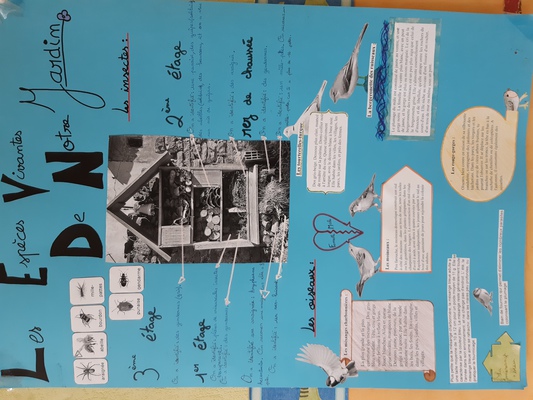Proposal for the working method :
I suggest you work according to a scientific method.
Each school must create a page to place all the work done.
The first step should be an observation of the biodiversity in your school by making a plan or a poster about the animal and plant species that are present.
Example :


Indeed, even if the title of the project is plant health, this health is directly related to biodiversity. Improving biodiversity also improves plant health.
From this first assessment, students must decide on one or more actions to be done in their school.
You can use here the site "Biodiversity in Schools" which offers many examples of actions.
So you have to present your page in several steps:
First stage :
Observations at the beginning of the project: place this document on the twinspace with pictures of animals, insects and plants that characterize your area.
These observations can also be the presence of a species that comes from another country and destroys the biodiversity of your area.
Second step: find an element to improve in relation to biodiversity. Find a solution to do it.
Last step: manufacture, create a solution and make observations to know if it has a positive effect on biodiversity
You can use to this method :
Escola Frei Manuel de Santa Inês, Portugal
Map

. To describe the initial situation regarding plants we used thinglink to locate them in our school.
Pl@ntNet is an application that allows you to identify plants simply by photographing them with your smartphone. Very useful when you don't have a botanist on hand! Pl@ntNet is also a great citizen science project: all the plants you photograph are collected and analysed by scientists around the world to better understand the evolution of plant biodiversity and to better preserve it.
Pl@ntNet allows you to identify and better understand all kinds of plants living in nature: flowering plants, trees, grasses, conifers, ferns, vines, wild salads or cacti. Pl@ntNet can also identify a large number of cultivated plants (in parks and gardens) but this is not its primary purpose. We especially need Pl@ntNet’s users to inventory the wild plants, those that you can observe in nature of course but also those that grow on the sidewalks of our cities or in the middle of your vegetable garden!
The more visual information you give to Pl@ntNet about the plant you are observing, the more accurate the identification will be. There are indeed many plants that look alike from afar and it is sometimes small details that distinguish two species of the same genus. Flowers, fruits and leaves are the most characteristic organs of a species and it is them that should be photographed first. But any other detail can be useful, such as thorns, buds or hair on the stem. A photograph of the whole plant (or the tree if it is one!) is also very useful information, but it is often not sufficient to allow a reliable identification.
At present Pl@ntNet makes it possible to recognize about 20,000 species. We are still a long way from the 360,000 species living on earth, but Pl@ntNet is getting richer every day thanks to the contributions of the most experienced users among you. Don't be afraid to contribute yourself! Your observation will be reviewed by the community and may one day join the photo gallery illustrating the species in the application.
The new version of Pl@ntNet released in January 2019 includes many improvements and new features:
- The ability to filter recognized species by genus or family.
- The differentiated data revision that gives more weight to users who have demonstrated the most skills (in particular the number of species observed, validated by the community).
- The re-identification of shared observations, whether yours or those of other users of the application.
- The multi-flora identification that allows you to search for the photographed plant in all the flora of the application and not only in the one you have selected. Very useful when you are not sure what flora to look for.
- The selection of your favorite floras to access them more quickly.
- The navigation at different taxonomic levels in image galleries.
- The mapping of your observations.
- Links to many factsheets.
The web version of the application is also available at the following address: https://identify.plantnet.org/
Maia Porombrica